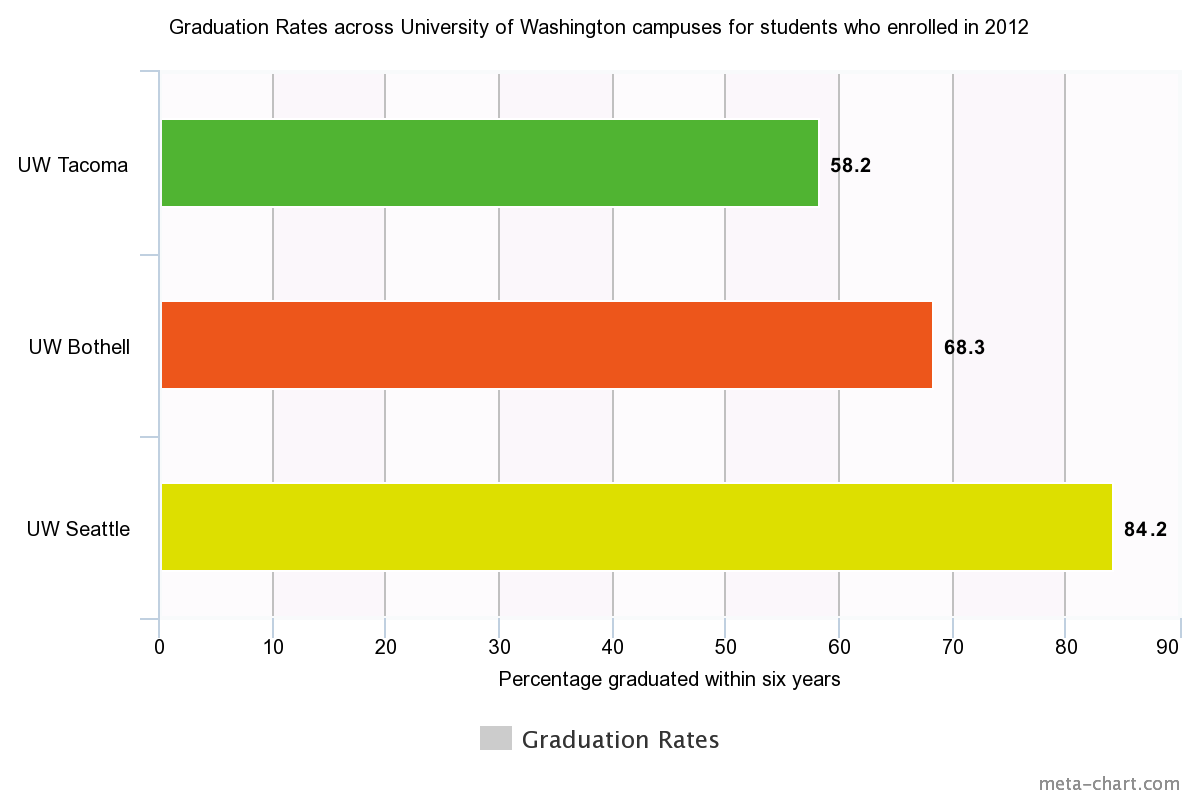UWT Student Investigators; Do college graduation rates matter?
By Madison Cook
Students have many factors to consider when looking at which college to attend. Knowing what a university has to offer is important before committing to a two, four and sometimes even six-year journey. But what if the choices in a state school system are dissimilar — in size, income, and diversity of its student body?
UW Tacoma’s graduation rates look low compared to its Seattle and Bothell sister campuses. For full-time students entering UWT directly from high school in fall 2012, 58.2 percent graduated in six years, compared to 62.3 percent of students at UW Bothell and 84.2 percent at UW Seattle, according to UW Public Profiles.
The numbers improve when considering full and part-time students transferring to UWT from two-year community colleges and other programs. Then the six-year graduation rate jumped to 83 percent for UWT, compared to 86 percent for students attending Seattle or Bothell.
It is the four-year graduation rate that raises the most concern. For full-time students entering UWT directly from high school in fall 2012, just 46.5 percent graduated in four years. That number was slightly lower, 45.9 percent, for students who graduated in 2018.
“Why work so hard for something you might not even get at the end?” UWT senior Connor Mckearnan said.
What the statistic does not explain is that much of the UWT campus is filled with nontraditional students. More than 90 percent of UWT students commute to campus, and many hold down full-time jobs while they attend classes.
When Senior Marissa McDowell was deciding between UWT and UW Seattle, she knew what she wanted from her college experience. McDowell considered quality of life factors, such as tuition cost, her ability to work, and her commute.
“UW Tacoma has allowed me to experience university life but not have to leave home or stop working,” McDowell said.
But then she looked for graduation rates to find out if she would be able to get what she and her parents were paying for. McDowell found that these rates aren’t always easy to find.
“We really don’t mention graduation rates to students,” Senior Admissions Adviser Noelle Wilson said.
When Wilson is talking with prospective students she always explains how UWT can be whatever students make of it.
“We really try to find a good fit for students at UW Tacoma and want them to be able to get what they want out of a college experience,” Wilson explained.
For many students, a good college experience includes graduating with a degree. But when comparing Tacoma to other universities, it is important to consider the school’s history.
Tacoma only began accepting four-year students in 2006. The first class’s six-year graduation rate — ending in 2012 ¸— was just 43 percent. But UWT spokesman Mike Wark said that number was likely affected by the relatively new experience of having students on campus for the entirety of their schooling. The graduation rate has risen with time, to its current rate of 58.2 percent.
Alice Few, Director of Institutional Research, explained that graduation numbers alone do not tell the whole story. UWT far outpaces both Bothell and Seattle on a number of diversity measurements. Thirty-two percent of Tacoma students are classified as “underrepresented minorities,” compared to 21 and 14 percent for Bothell and Seattle, respectively. Fifty percent of all UWT students are eligible for Pell grants, indicating greater financial need, and nearly a third of Tacoma students are first-generation with no immediate family members with college experience.
“UWT is looking for a better set of peer institutions to compare rates with a similar size of commuter students and diverse students,” Few said.
This would allow for an even playing ground for students to look at when considering schools.

